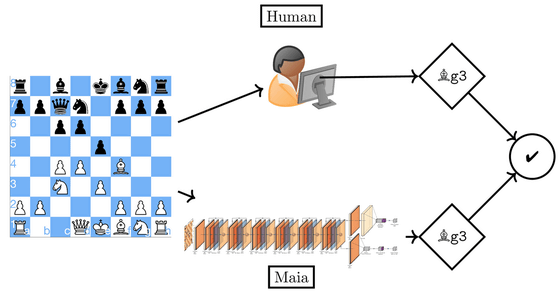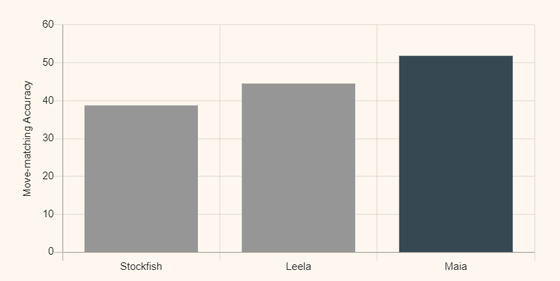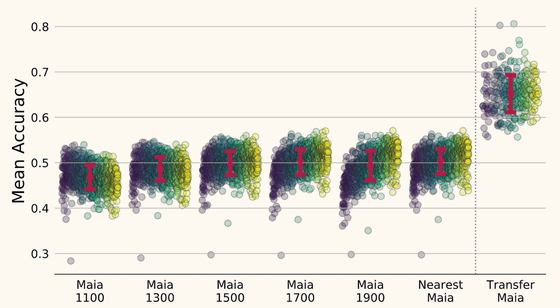Neural network chess engine 'Maia' that realizes more human-like pointing than normal chess AI

' Maia ' is a neural network chess engine that allows you to play chess like a human being. By learning from human chess pointing, Maia can realize more human-like pointing lines than other chess AI, and can also learn 'what kind of mistakes chess players make' from AI models. ..
[2006.01855] Aligning Superhuman AI with Human Behavior: Chess as a Model System
Maia Chess
https://maiachess.com/
Maia is a deep learning framework similar to the computer program ' AlphaZero ' developed by DeepMind under the umbrella of Google, the developer of ' AlphaGo ', which became a hot topic after defeating a professional Go player . Maia not only plays chess on her own and learns about chess, but also learns chess from the human pointing of playing chess online. Maia tries to predict how humans are pointing correctly by training with millions of chess game records .

The graph below shows how well the chess AI points match with human play. The vertical axis of the graph shows the 'match rate with human pointing muscles', and it can be seen that the higher the number, the more chess AI can be played, which is similar to human play.

Experiments have also been conducted in which multiple players playing chess online games are gathered, divided into nine groups according to their skills, and Maia is trained separately using the game records of each group. The experiment will 'learn what chess players at a particular level are pointing at,' the development team said.
Maias trained in different skill groups are called Maia 1100-1900, and the numbers are higher for Maias trained by more capable player groups. The following shows what level of Maia points to the wrong move (b6) taken by humans in chess. The four models from Maia 1100 to 1400 point to the same wrong move (b6), while the five models from Maia 1500 onwards point to another better move (bxa6). This result shows that 'more advanced chess players will not commit this wrong move (b6)'. In addition, it seems that Stockfish of chess AI also points to the same move (bxa6) as after Maia 1500.

By training chess AI, it's easy to be able to predict good pointing. However, Maia is particularly good at predicting the wrong way of pointing humans, which can help us understand 'how an inexperienced chess player makes a mistake.' In other words, the developers claim that Maia can be treated as a 'useful chess learning tool.'
In addition, by training each model of Maia 1100-1900 only with the game record of a specific chess player, it is possible to further improve the prediction accuracy of that player's pointing. In fact, by training the Maia 1900 using a particular chess player's game record, we have succeeded in predicting the chess player's points used for training with an accuracy of up to 75%.

The source code of Maia is available on GitHub.
GitHub --CSSLab / maia-chess: Maia is a human-like neural network chess engine trained on millions of human games.
https://github.com/CSSLab/maia-chess

Related Posts:
in Software, Posted by logu_ii







